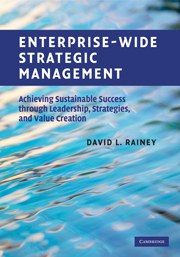 Enterprise-Wide Strategic Management
Enterprise-Wide Strategic Management Book contents
- Frontmatter
- Contents
- List of figures
- List of tables
- List of boxes
- List of abbreviations
- Introduction
- Part I Context: Laying the foundation and the underpinnings of ESM
- Part II Strategic management: Formulation and implementation
- 6 Strategic management framework and strategic analysis
- 7 Strategic formulation – options, mission statements, and objectives
- 8 Strategy formulation – business strategies and action plans
- 9 Strategic implementation and execution
- 10 Reflections and concluding comments
- Index
- References
9 - Strategic implementation and execution
from Part II - Strategic management: Formulation and implementation
Published online by Cambridge University Press: 05 June 2012
- Frontmatter
- Contents
- List of figures
- List of tables
- List of boxes
- List of abbreviations
- Introduction
- Part I Context: Laying the foundation and the underpinnings of ESM
- Part II Strategic management: Formulation and implementation
- 6 Strategic management framework and strategic analysis
- 7 Strategic formulation – options, mission statements, and objectives
- 8 Strategy formulation – business strategies and action plans
- 9 Strategic implementation and execution
- 10 Reflections and concluding comments
- Index
- References
Summary
Introduction
Strategic implementation is the downstream side of the strategic management process. It focuses on converting business strategies into desired outcomes through systems, organizational structures, program design and development, resource allocations, and various other means and mechanisms. It also includes ongoing or periodic strategic analysis, strategy implementation, and strategic evaluation.
The strategic implementation process involves the outer loop of the overall strategic management process as portrayed in Figure 6.1. It links the front end inner loop of strategic formulation with the operating levels of the organization that are usually responsible for execution.
When taking place during strategic implementation, strategic analysis involves the ongoing or reaffirmation of the assessment of the business environment, market spaces, and internal aspects to determine whether significant changes have occurred or are expected to occur. As time marches forward the analysis conducted during strategic formulation may become outdated. Systematic reflection is required to ensure that if significant changes have occurred, they are considered by the strategic leaders and are incorporated in subsequent decision making. Strategic leaders can then modify the business strategies or adapt the implementation processes to reflect the new realities.
Strategic implementation is interrelated with strategy formulation and an essential part of enterprise-wide strategic management (ESM). It focuses on high-level management constructs to do the following: (1) reinvent, modify, and/or adapt the management systems; (2) restructure or improve the organization; and (3) provide the means to upgrade and refine the support mechanisms that are necessary to achieve results.
Information
- Type
- Chapter
- Information
- Enterprise-Wide Strategic ManagementAchieving Sustainable Success through Leadership, Strategies, and Value Creation, pp. 428 - 488Publisher: Cambridge University PressPrint publication year: 2009